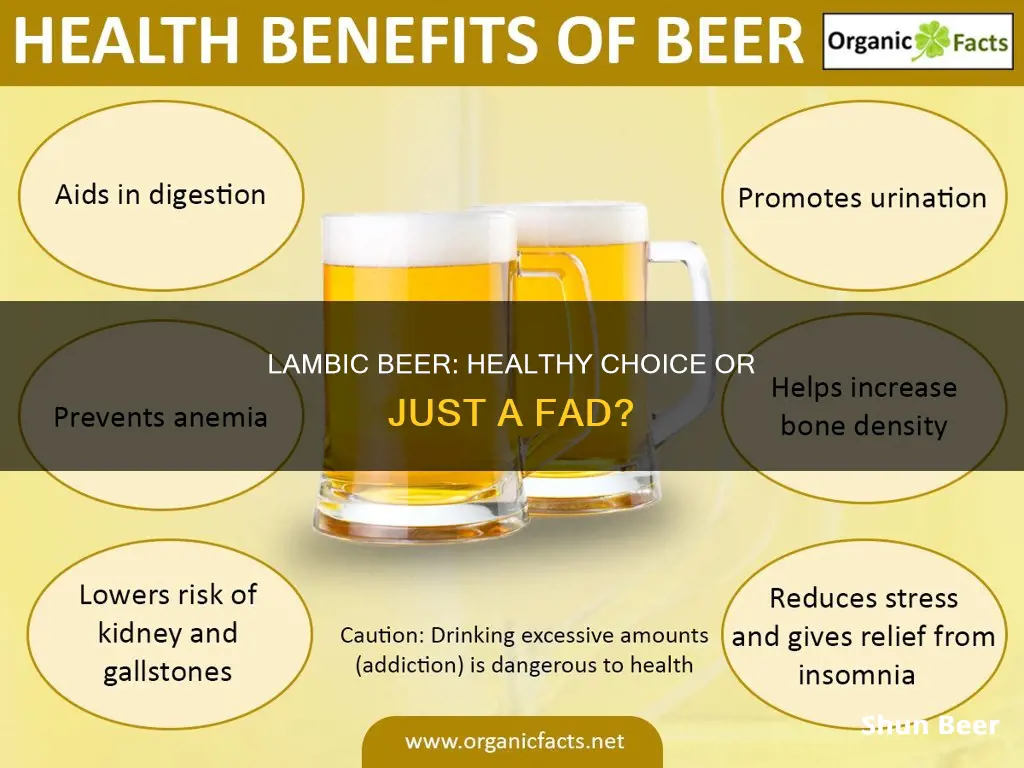
Lambic beer is a spontaneously fermented beer, with its roots in Belgium. It is often associated with fruit beer, but in its most basic form, it is called straight lambic, which is unsweetened and unflavoured. Lambic beer has been touted as having several health benefits, but is it really healthy?
Lambic beer is a product of both yeast and bacterial fermentation, resulting in a beverage that is more probiotic than most beers. This means it may contribute to healthy gut flora. It is also fermented bone dry, with little residual sugar, which could be beneficial for those monitoring their sugar intake. Additionally, lambic beers tend to be lower in alcohol content and hops, which have been associated with lower testosterone levels.
While lambic beer may have some health benefits, it is still a beer, and excessive alcohol consumption is harmful. However, when consumed in moderation, lambic beer could be considered a healthier option compared to other beers.
| Characteristics | Values |
|---|---|
| Lambic beer is a product of | Yeast and bacterial fermentation |
| Lambic beer is | More of a probiotic than most other beer styles |
| Lambic beer is | Fermented bone dry with little residual sugar |
| Lambic beer has | Relatively low amounts of hops |
| Lambic beer is | Typically lower in alcohol |
| Lambic beer | May be certified organic |
What You'll Learn

Lambic beer is a probiotic
Lambic beer is typically fermented bone dry, with little residual sugar. An example of this is Cantillon beer. While this does not make it an ideal drink for diabetes patients, it is still a healthier option than beer styles with a lot of residual sugars, such as imperial stouts or barley wines.
Lambic beers also tend to be lower in alcohol, usually with an alcohol percentage between 4.5% and 6%. This is much lower than many other beers, which can have alcohol percentages of 10% or more.
The bacteria in lambic beer, specifically in gueuze, are probiotic and can contribute significantly to colon health. In fact, the health benefits of drinking lambic have been promoted throughout its history as an excellent reason to purchase it.
However, it is important to note that the health benefits of lambic beer may need to be further qualified and may only be applicable to certain populations, genders, and age groups. Additionally, the potential health benefits of lambic beer do not negate the risks associated with excessive alcohol consumption, including alcoholism and lower testosterone levels.
Beer and Pregnancy: Is It Safe for Expecting Mothers?
You may want to see also

It has less residual sugar than other beers
Lambic beer is typically fermented bone dry, meaning it has little residual sugar. This makes it a better option for people with diabetes than beer styles with a lot of residual sugars, such as imperial stouts or barley wines.
While this doesn't make lambic beer an "ideal" drink for diabetes patients, it is certainly a healthier option than other beers with high residual sugar content. This is because the body breaks down residual sugar into glucose, which can cause blood sugar spikes and increase the risk of diabetes complications.
Additionally, the low residual sugar content of lambic beer can also be beneficial for weight management. Sugary drinks, including beers with high residual sugar, can contribute to weight gain and increase the risk of obesity. By choosing a lambic beer with less residual sugar, individuals can reduce their sugar intake and potentially maintain a healthier weight.
It is important to note that while lambic beer has less residual sugar, it is still an alcoholic beverage. Excessive alcohol consumption can have negative health effects, including liver damage, high blood pressure, and an increased risk of heart disease. Therefore, it is important to consume lambic beer in moderation as part of a balanced and healthy lifestyle.
German vs American Beer: Which is Healthier?
You may want to see also

It has fewer hops than most beers
Lambic beer is characterised by its spontaneous fermentation process, where the beer is exposed to the open air to be inoculated by naturally occurring microorganisms, flora, and bacteria from the environment. Lambic differs from most other beers in that it is fermented through exposure to wild yeasts and bacteria native to the Zenne valley in Belgium, rather than exposure to carefully cultivated strains of brewer's yeast.
Lambic beers are typically fermented with a blend of 40% unmalted wheat and 60% barley malt. The wort is then cooled in a coolship, a large, shallow, flat, metal pan, where it is left exposed to the open air. This cooling process is critical to the style of lambic beer, but it is also dependent on specific night-time temperatures, which can only be achieved between October and May. Lambic brewers use large amounts of hops for their antibacterial properties, but they try to avoid making the beer extremely hop-forward. Lambics use aged, dry hops, which have lost much of their bitterness, aroma, and flavour. Consequently, lambics often have a strong, cheese-like, "old hop" aroma, in contrast to the resiny, herbal, earthy hop bitterness found in other styles.
Lambic beers are only produced near Brussels due to that region's natural microflora. Lambic has been brewed in Belgium since the 13th century, and the style has deep roots and tradition there. Theories vary as to where the term “lambic” came from, but most beer scholars agree that it probably originated from the town name, Lembeek, in Belgium. Lambic beers have an air of mystery and intrigue, and while the style has been emerging in the United States in the last decade, most Belgian brewers do not consider spontaneously fermented beer made outside of Belgium true lambics.
Beer for Hair: Healthy Shine or Foamy Disaster?
You may want to see also

It is lower in alcohol
Lambic beer is typically lower in alcohol content than other beers. While some American "wild ale" brewers may opt for higher alcohol percentages, traditional lambic beer usually has a modest alcohol content, ranging from 4.5% to 6%. This relatively low alcohol percentage is one of the aspects that make lambic beer a healthier option compared to other beer styles.
Alcohol is a strong diuretic, which means it can increase the urge to urinate and lead to dehydration. Excessive alcohol consumption can also contribute to lower testosterone levels in both males and females. By having a lower alcohol percentage, lambic beer may help mitigate some of the negative effects associated with alcohol consumption.
It is important to note that while lambic beer may have some potential health benefits due to its lower alcohol content, it does not mean it is completely healthy. Excessive consumption of any alcoholic beverage, including lambic beer, can lead to health issues such as alcoholism and associated risks. Therefore, it is always important to consume alcohol in moderation and be mindful of one's overall health and well-being.
Gin and Tonic: A Healthier Alternative to Beer?
You may want to see also

It is often organic
Lambic beer is often organic, with many brewers leaning towards the use of organic ingredients and abhorring the use of artificial ingredients or processes. This is because lambic beer is a more natural product, being the result of both yeast and bacterial fermentation. As a result, it is a more logical choice for those who believe in a diet and lifestyle closer to that of our ancestors, such as the Paleo Diet.
Lambic beer is also typically fermented bone dry with little residual sugar. This means that it is not an ideal drink for diabetes patients, but it is a healthier option than beers with a lot of residual sugars, such as imperial stouts or barley wines.
The use of organic ingredients in lambic beer is also related to the type of hops used. Lambic beers have relatively low amounts of hops. The hops used in lambic beer are aged and dry, which means that they have lost much of their bitterness, aroma, and flavour. This is because lambic brewers are less interested in the hops' bitterness and more in their natural preservative qualities.
The organic nature of lambic beer also extends to the type of barrels used during the fermentation process. Lambic is fermented and matured in old port wine or sherry barrels made of chestnut or oak from Portugal or Spain. The lambic is left to ferment and mature for one or several years, forming a velo de flor of yeast that gives some protection from oxidation.
Draught Beer: Healthy Beverage or Just a Fad?
You may want to see also
Frequently asked questions
Lambic beer is not a health food, but it does have some health benefits that other beers do not.
Lambic beer is more of a probiotic than other beers, which can help with heart health and digestive health. It also has very little residual sugar and fewer hops than most beers.
Lambic beer is an entirely spontaneously-fermented beer, hailing from Belgium. It is known for its sour, fruity taste.
Lambic beers are known for their sour, fruity taste. People who taste lambic beers also will notice an earthy, barnyard note that seems to honor the natural fermentation process.
Lambic beer is made through a spontaneous open fermentation process that naturally uses the yeast from the brewery and region in which it resides. No yeast is added by the brewer.







